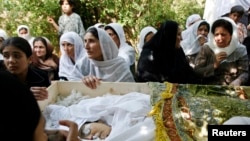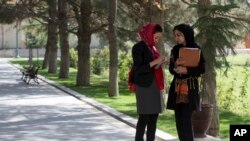Negeena Anwari works for Hewad Television, a private channel in southern Afghanistan's Kandahar Province, the birthplace and spiritual home of the Taliban where every woman is a potential target.
But for Anwari, Taliban guns are a less vexing problem than the daily harassment she endures as a publicly recognizable broadcast anchor in Afghanistan's second-most populous city.
“Our traditional problems and harassments are bigger than our security problems,” says the young journalist, explaining that concerns about national security, while legitimate, don't discriminate between gender or profession.
“The moment I walk out of my home, I am bombarded by verbal intimidations and abuse by almost every man I face," she says. "They insult me for appearing on TV and some even call for my death.”
Free media has boomed in post-Taliban Afghanistan — even in Kandahar, former base of Mullah Mohammad Omar, the Taliban’s fugitive spiritual leader. And while it is unclear exactly how many female journalists work here, Nageena’s problems are not exceptional.
According to local news radio host Haseena Ahmadi, female Afghan journalists represent a small enough professional minority to become well known throughout the regions they cover, thereby falling prey to myriad threats, harassment and discrimination.
“Parents don’t permit their daughters to become journalists [in particular] because female journalists soon turn popular and that puts them in lots of troubles,” Ahmadi says. Unlike other female Afghan professionals targeted by Kandahar-based extremists — the Taliban have claimed responsibility for assassinating Lt. Col. Malalai Kakar, head of Kandahar's department of crimes against women and the country's most prominent policewoman, and multiple women in elected office — the violence isn't restricted to the southern provinces.
Even in the relatively peaceful north of Afghanistan, some female reporters are facing the very same problems as their colleagues along the Pakistan border.
“People look at female journalists as bad girls who have no morality,” Saleha Fahim, a reporter with Arezo TV in the northern Balkh Province, told VOA Dari. Soma, another journalist who goes by one name and works for a private TV channel in Balkh Province, says she clads herself from head to toe in order to avert harassment on the streets.
“We’re forced to wear burqa,” she says.
While Afghan development indicators have shown marked improvement over the past decade, Fahim says the situation for female journalists has deteriorated over the last two years in particular.
A recent report by The New York Times calls 2014 "by far the deadliest year for the news media here since the fall of the Taliban," and reports the Sept. 16 stabbing death of 27-year-old Palwasha Tokhi, the seventh journalist killed in the country this year. Tokhi, formerly of Mazar-i-Sharif's Bayan radio, was fatally assaulted by an unidentified assailant outside of her home.
According to media support organizations, dozens of journalists have been killed on Afghan soil since 2002. What's less clear, however, is exactly how many female Afghan journalists have lost their lives since the U.S. invasion.
And even though the exact motives behind the killings of several prominent female journalists — Shakiba Sanaga Amaj, Nazifa Zaki and Shaima Rezayee — are unclear, it is known that none perished in random war-related incidents.
Unpromising future
The four journalists interviewed for this story all said that even though a career change might mitigate their plight — traditionally, Afghan women assume relatively lower-profile jobs than men — reporting is worth the risk.
“I love journalism despite that in being a journalist I face risks and threats every day,” said Anwari, the Kandahar-based television anchor. “Some days I hear men warning me that it would be my last day, but I say 'let it be the last day in my life as a journalist.'”
Armed violence shows no signs of slowing in Afghanistan, where concern abounds over the planned, gradual US disengagement, which, some say, could reverse gains made by women’s rights advocates.
As donors shift their focus to other hotspots in the Middle East and Africa, Afghan media outlets — which, thus far, have mostly survived with foreign funding — are already seeing financial resources dwindle.
“The general feeling is that media will struggle to survive,” says Bob Dietz, Asia program director at Committee to Protect Journalists, adding that the Afghan media landscape is likely to shrink in coming years.
Future employment prospects look particularly grim for women. “Many are the first to be let go when outlets downsize,” said Dietz.
“For women journalists, it’s a double-indemnity situation: Not only are journalists under pressure, but as women they suffer yet another source of discrimination.”
Akmal Dawi is a managing editor with VOA’s Afghan Service. He previously worked for the UN and BBC World Service in Afghanistan. He tweets from @Kabul3.














